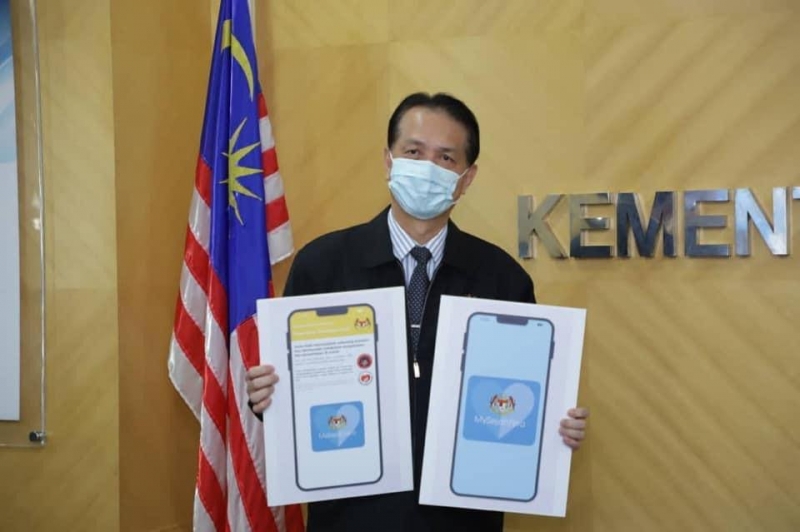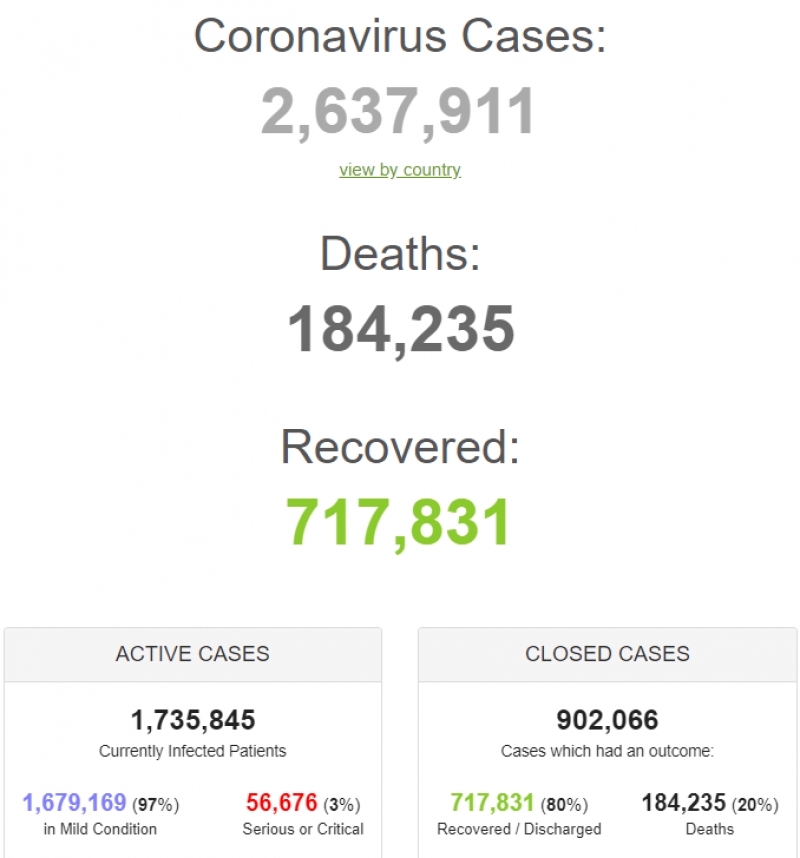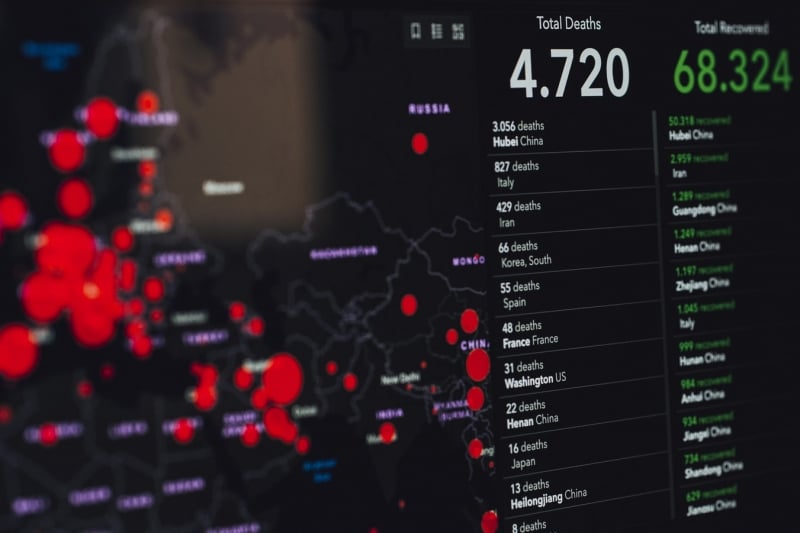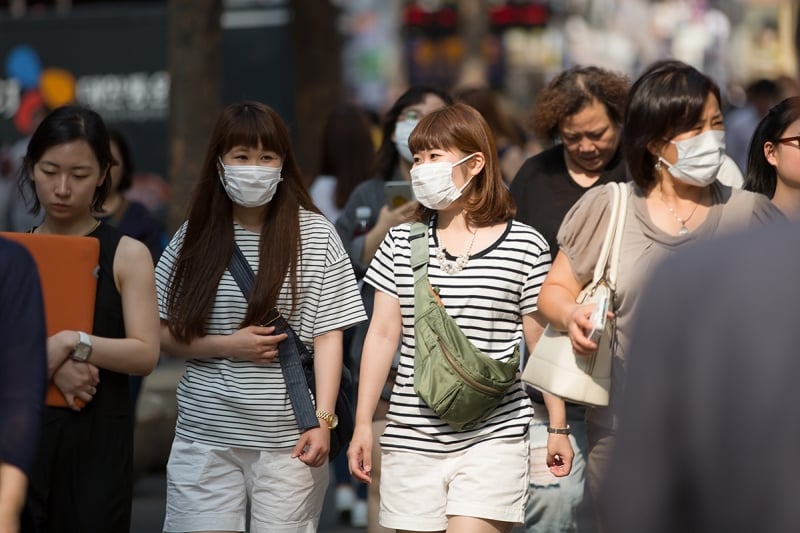Regardless of which part of the world you’re from or in, there’s no getting away from news about COVID-19. Be it on Facebook, Twitter, or any other social media platform, you’re likely to stumble upon coronavirus content the moment you go online. And since most of us are currently stuck at home, it’s inevitable that we’ll be bombarded with information about the pandemic during our every waking moment, especially regarding the latest COVID-19 numbers.
Now, I’m not going to downplay the severity of this situation. After all, at the time of writing, the number of infections worldwide is inching towards the three million mark, with over 180,000 people having lost their lives. In fact, that number may even be higher if you consider unreported or missed cases. It’s not “just a flu”, it’s not “fake news”, and it’s certainly not a “communist agenda” as suggested by a small minority of anti-lockdown protesters in America.
However, I can’t help but feel like a part of the anxiety surrounding COVID-19 is simply an unintentional media frenzy. Again, I’m not downplaying the situation. However, I AM calling out the media for the way many publications report on the situation.
COVID-19 is NOT a number’s game!
The problem with most news reports on the coronavirus is that many of them lead in with the big numbers. The most common headline you’ll probably see is “number of cases surpass X thousand, X deaths reported” etc. That’s all well and good, but many publications also stop short of further elaborating on those numbers. Given how many people on social media these days merely read a headline and assume they understand the gist of the article, this can easily lead to misinformation.
More tests = more cases
For one, let’s consider the factors that might affect the number of reported cases in a day. Let me cite an example from my own country, Malaysia. For those not in the know, Malaysia entered into a partial lockdown on 18 March 2020. Before the lockdown, we were processing an average of 3,500 COVID-19 tests per day. From that, we had an average return of about 100++ positive cases.
A few days after the lockdown, the daily numbers shot up to about 250. The news media reported it and Malaysians from all walks of life started freaking out. But there was actually a very simple explanation for this. As part of Malaysia’s plan to contain the spread, the government converted certain hospitals and medical labs into COVID-19-exclusive institutions. This allowed us to double the number of daily tests to 7,000. As of 23 April, the capacity is now at 11,500.

Dr. Noor Hisham, Malaysia’s Director General of Health, hailed as one of the world’s top COVID-19 doctors by CGTN l Image credit: Noor Hisham Abdullah
Let’s do the math, from 3,500 tests, Malaysia got an average of 100++ positive cases. With 7,000, they had 200++. So basically, the rate of infection, according to the numbers, actually remained generally unchanged. But because of the way the media reported it (highlighting the numbers but failing to indicate the increase of testing), many people, at that time, believed that Malaysia would “become the next Italy”.
The same can be said of Singapore’s recent spike in cases. On paper, it looks extremely alarming. While it certainly poses a potential problem for the country’s healthcare system and brings to light other social issues that need to be urgently addressed, it isn’t exactly the “armageddon” that some papers make it out to be. At least not yet. That’s because a large number of the new casesstem from a particular location or group (cluster).

Due to that, the Singapore authority is likely conducting focused screening targeting those communities. And as seen in the example of Malaysia, more tests equals more positive results. That means that, despite the harrowing numbers, at the moment, containment is still very much possible. Even if we address the big elephant in the room that trumps (ba-dum-tss) every country in the world (U.S.A), the same factors apply.
While it’s undeniable that America has a higher than average infection rate (almost 20% or 1 in 5 of all who were screened tested positive), it doesn’t take away from the fact that the U.S. has conducted more tests (over 4.3 million) than any other county during the pandemic. So while we can point the finger at the American administration and blame them for their poor initial handling of the situation, it would be really foolish to assume with certainty that America is the worst-hit country (not saying it isn’t) based solely on their total number of cases.
Also read: COVID-19 Quarantine Tips: What To Do if You Get Stuck in Another Destination
Total cases vs. active cases vs. rate of infection (ROI)

Image credit: Worldometers
Another faux pas that many publications are at fault for is selectively reporting only a certain set of numbers. The criteria of choice? Sensationalism. Here, I want to point out the difference between “Total Cases” and “Active Cases”. Most media outlets will focus on “total cases”, which is something that I find to be quite annoying. Now, I don’t think it’s bad to keep track of the total number of infections. I just think that, for ordinary people like us, it’s a waste of time.
That’s because like most statistics, the number of total cases will only ever increase and never go down. If media outlets play it right, they can paint a devastating picture. One that depicts a never ending rise in new infections, even when it’s not the case. In Malaysia, the total number of cases as of 23 April is 5,532. However, the number of “active cases” (infectious patients being treated) is only 1,987, with over 3,400 patients having recovered. Guess which number our media publications cite more often? Yep, the bigger one.

You see, the number of “total cases” is nothing more than a statistic. To put it crudely, it’s simply a number that gets inserted into history books for future generations. At present, it means very little, especially for countries that have successfully flattened their infection curve. The number of “total cases” in this sense does not accurately reflect the capacity of their medical institutions. It also fails to offer any viable information regarding the current containment efforts of the virus.
Even for frontliners and those working to curb the spread, the “total number” isn’t necessarily the most important number. Rather, it’s the daily number of new cases that offer a clearer idea regarding the current rate of infection (ROI) and help determine the next course of action. If you’ve noticed, every time a country declares a lockdown over COVID-19, most headlines that report it go along the lines of “Country A declares emergency lockdown after COVID-19 cases surge past X Numbers!”.
On face value, it looks like it makes a lot of sense. But when you dive deeper and think about it, it really doesn’t. That’s because if, for example, a country with a large population experiences a very slow ROI despite conducting a large number of screenings — even if the total number of cases reach a certain point — said country would probably not declare a lockdown.

Does such a country exist? Yes – South Korea. In February, the country emerged as the new epicentre of the coronavirus, stemming from a surge of infections in Daegu. In response, the government sealed off that city along with certain nearby provinces. At the time, their total number of cases were merely around the 2,000 mark. .
Today, that number has reached over 10,000! Despite that, South Korea remains one of the few countries in the world that have not imposed a nationwide lockdown. That’s because while their total numbers look dangerously high, their current ROI suggests that there is no need for such drastic action. In fact, many medical professionals around the world consider them a success story of early COVID-19 containment!
So, despite the media’s fascination with the “total numbers”, it actually does nothing but stoke panic and fear. But even if media outlets resort to focusing on the number of new cases per day, if left unexplained, it can also lead to a different kind of misconception.
An unfortunate misunderstanding
First, let’s revise a little bit about what we now know about the coronavirus. It’s highly infectious, spreads from person-to-person, and has an average incubation period of 14 days. You’re probably wondering why I’m bringing this up, right?
You see, with the world fixated on the numbers game perpetuated by certain media outlets, it’s easy to forget that it takes time for symptoms of the virus to present itself after infection. And since most people only go for a COVID-19 test after there is evidence that they are sick, it’s safe to assume that the number of new cases reported today could actually refer to patients who have been infected a long time ago.
However, sometimes when we read the endless reports of COVID-19 numbers, we might forget this fact and think that all these new cases represent people who were infected with the virus yesterday. Clearly, it isn’t. The numbers don’t represent the number of people who were infected, it reflects the number of positive test results that were obtained the day before.

Another important point to note is that testing for the novel coronavirus is a lot different than testing for other diseases like diabetes and hypertension. In those cases, you can often obtain a result almost instantaneously. However, COVID-19 results can sometimes take a bit more time, especially for countries that conduct a large number of screenings daily.
In Malaysia, at one point, given the facilities available for processing COVID-19 test samples, some results were backlogged for up to three days! So if there is a report that says that 400 new cases have been found, it might also include tests that were done a few days earlier. In most countries, those who undergo a COVID-19 test are legally required to quarantine themselves as they await the results. Even if they test negative, some countries require them to continue to be isolated for observation.
So, in short, the number of daily increases does not represent the sudden appearance of new patients. It merely represents the number of people in isolation who have tested positive for the virus. Basically,
Don’t let the numbers affect your mental health!
Despite everything that I’ve said, I’m not going to tell you to not keep track of COVID-19 news and numbers. That is ultimately your freedom and your choice. However, I just want to remind everyone not to let the media frenzy surrounding COVID-19 numbers get you down or affect your mental health.
We are living in an unprecedented time. It’s a mentally and emotionally stressful time for everyone, especially those currently undergoing quarantine. Unless you’re a frontliner, the numbers do not and should not affect how you personally cope with the pandemic.

After all, we’ve already been told countless times about the best hygiene practices to keep ourselves safe. And (rightfully), none of those practises use any number as a gauge. It’s not like I’m going to wash my hands four times a day when the number of cases of COVID-19 in my country is X but twice as many times when the number doubles, is it?
On the other hand, I know a few friends who’ve become so needlessly invested in the daily report of COVID-19 numbers that they’ve developed some form of anxiety. One of them even confessed to me that she broke down and sobbed one night. She’s a journalist, so she has a responsibility to follow the COVID-19 numbers.
Also read: 7 Self-Care Tips to Protect Your Mental Health During the COVID-19 Pandemic
I’m here to tell you: If you’re not a reporter, it is not your job to religiously follow the COVID-19 numbers, especially if the reports don’t elaborate on what the numbers may mean. Be kinder to yourself and socially distance yourself from social media once in a while. The numbers probably don’t mean as much as you think they do, so don’t let them be a source of frustration, anxiety, and panic.
All that I’ve said thus far comes from the standpoint of a media analyst. I am not a medical professional and thus I accept that there may be some oversight regarding certain areas. Should that be the case, I would be most grateful if there are any medical professionals out there who could set me straight.
Finally, to all the brave men and women on the frontlines, from nurses and doctors, to medical workers, cleaners, police, and even those involved in food delivery services, thank you from the bottom of my heart. Stay safe everyone, and stay at home!




